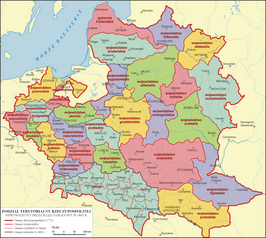Our website is made possible by displaying online advertisements to our visitors.
Please consider supporting us by disabling your ad blocker.
January Uprising
This article needs additional citations for verification. (February 2024) |
| January Uprising | |||||||
|---|---|---|---|---|---|---|---|
| Part of the Polish-Russian wars | |||||||
 Poland - The Year 1863, by Jan Matejko, 1864, oil on canvas, 156 × 232 cm, National Museum, Kraków. Pictured is the aftermath of the failed January 1863 Uprising. Captives await transportation to Siberia. Russian officers and soldiers supervise a blacksmith placing shackles on a woman (Polonia). The blonde girl next to her represents Lithuania. | |||||||
| |||||||
| Belligerents | |||||||
|
Supported by: |
| ||||||
| Commanders and leaders | |||||||
|
|
| ||||||
| Strength | |||||||
| At least 220,000 by June 1864. | Around 200,000 over the course of the uprising. Around 20 men of the Garibaldi Legion. | ||||||
| Casualties and losses | |||||||
|
Russian estimates: 4,500 killed, wounded and missing[1] Polish estimates: 10,000 killed, wounded and missing |
Polish estimates: 10,000 to 20,000 Russian estimates: 30,000[1] (22,000 killed and wounded, 7,000 captured[2]) | ||||||


The January Uprising[a] was an insurrection principally in Russia's Kingdom of Poland that was aimed at putting an end to Russian occupation of part of Poland and regaining independence. It began on 22 January 1863 and continued until the last insurgents were captured by the Russian forces in 1864.
It was the longest-lasting insurgency in partitioned Poland. The conflict engaged all levels of society and arguably had profound repercussions on contemporary international relations and ultimately transformed Polish society.[4]
A confluence of factors rendered the uprising inevitable in early 1863. The Polish nobility and urban bourgeois circles longed for the semi-autonomous status they had enjoyed in Congress Poland before the previous insurgency, a generation earlier in 1830, and youth encouraged by the success of the Italian independence movement urgently desired the same outcome. Russia had been weakened by its Crimean adventure and had introduced a more liberal attitude in its internal politics which encouraged Poland's underground National Government to plan an organised strike against their Russian occupiers no earlier than the spring of 1863.[4] They had not reckoned with Aleksander Wielopolski, the pro-Russian archconservative head of the civil administration in the Russian partition. In an attempt to derail the Polish national movement, he brought forward to January the conscription of young Polish activists into the Imperial Russian Army for 20-year service. That decision is what triggered the January Uprising of 1863, the very outcome that Wielopolski had wanted to avoid.[5]
The rebellion by young Polish conscripts was soon joined by high-ranking Polish-Lithuanian officers and members of the political class. The insurrectionists, as yet ill-organised, were severely outnumbered and lacking sufficient foreign support and forced into hazardous guerrilla tactics. Reprisals were swift and ruthless. Public executions and deportations to Siberia eventually persuaded many Poles to abandon armed struggle. In addition, Tsar Alexander II hit the landed gentry hard and, as a result, the whole economy, with a sudden decision in 1864 for finally abolishing serfdom in Poland.[6] The ensuing breakup of estates and destitution of many peasants convinced educated Poles to turn instead to the idea of "organic work", economic and cultural self-improvement.[7]
- ^ a b Польское восстание 1863 // Большая российская энциклопедия : [в 35 т.] / гл. ред. Ю. С. Осипов. — М. : Большая российская энциклопедия, 2004—2017.
- ^ Айрапетов О. Р. Польское восстание 1863 года. Русский сборник, Том XV, стр. 132
- ^ Znamierowski
- ^ a b Zdrada, Jerzy. "Powstanie styczniowe". Muzeum Historii Polskiej. Archived from the original on 23 November 2020. Retrieved 19 June 2018.
- ^ Chisholm, Hugh, ed. (1911). "Wielopolski, Aleksander". Encyclopædia Britannica. Vol. 28 (11th ed.). Cambridge University Press. p. 622.
- ^ Bardach, Juliusz; Lesnodorski, Bogusław; Pietrzak, Michał (1987). Historia państwa i prawa polskiego. Warsaw: Państwowe Wydawnictwo Naukowe. pp. 389–394. ISBN 83-01-07919-3.
- ^ Maciej Janowski (2004). "The Rise of Positivism". Polish Liberal Thought Before 1918. Central European University Press. p. 166. ISBN 9639241180. Retrieved September 7, 2012.
Cite error: There are <ref group=lower-alpha> tags or {{efn}} templates on this page, but the references will not show without a {{reflist|group=lower-alpha}} template or {{notelist}} template (see the help page).
Previous Page Next Page


